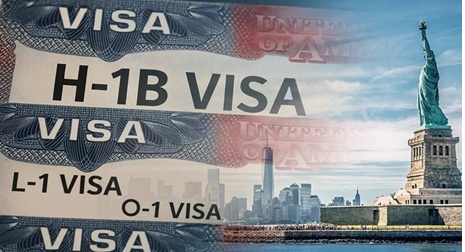(Prelims: Current Events)
(Mains, General Studies Paper 2: Impact of Policies and Politics of Developed and Developing Countries on India's Interests; Overseas Indians) |
Context
- The United States has announced a substantial increase (up to $100,000) in the application fee for new H-1B visas. This move has sparked concern and a search for alternatives among Indian professionals. In this context, the L-1 visa is being considered as an alternative option.
- These changes come into effect on September 21, 2025. New visa applications will now incur a fee of over ₹8 million (approximately $8 million), compared to the previous fee of only $215 to $5,000.

- Some of the top companies hiring foreigners are: Amazon, TCS, Microsoft, Meta, Apple, Google, etc.
- The Recent Issue of H-1B Visa Fee Hike
- The Donald Trump administration in the United States has increased the current H-1B application fee.
- This fee has reached $100,000 for the new H-1B visa facility.
- This has had a financial and professional impact on Indian IT and multinational company (MNC) professionals.
Impact on Indian Professionals
- Applying for an H-1B has become expensive and challenging.
- Opportunities for Indian IT workers will be limited.
- Large MNCs will be forced to look for other options for their employees.
- India (with approximately 73%) leads the list of H-1B holders, followed by China (~12%), the Philippines (1%), Canada (1%), and South Korea (1%).
About the L-1 Visa Option
- Introduction: The L-1 visa is a non-immigrant work visa that allows employees of multinational companies to transfer from their overseas offices to U.S. offices.
- Eligibility: Must have worked at a branch/subsidiary/affiliate of a multinational company for at least 1 year in the past 3 years.
- L-1A: Executive/Managerial Role
- L-1B: Specialized Knowledge Role
- Applicant: Only companies can apply; no individual applicants.
Features
- No Quota: No Annual Limit
- Blanket Petition: Larger companies can apply faster.
- Dual Intent: No barrier to applying for a Green Card.
- L-2 Visa: Automatic work permit for spouse.
Benefits
- No lottery or annual limit like the H-1B
- Employee can be transferred to a US branch of the same company
- Spouse can work
Limitations
- Transfer only within the same company
- No transfer to another employer (portability)
- Time limit: 5 years for the L-1B and 7 years for the L-1A
- No extension possible while awaiting green card processing like the H-1B
|
Comparison of H-1B and L-1 visas
|
|
Feature
|
H-1B Visa
|
L-1 Visa
|
|
Eligibility
|
Professionals in specialized fields
|
Company transfer employees
|
|
Annual Limit
|
85,000
|
No limit
|
|
Salary Requirement
|
Prevailing wage
|
No minimum salary required
|
|
Application Type
|
Individual + Company
|
Company sponsored only
|
|
Spouse Rights
|
H-4: Limited
|
L-2: Automatic work authorization
|
Is the L-1 really an alternative to the H-1B ?
- Public opinion: Not for most employees.
- Large companies already use the L-1.
- There are no options for students and new employees.
Conclusion:
The H-1B visa is still the main route for professionals from India. The L-1 visa is a lucrative option for specialists and high-level employees. Companies freely use both visa routes.
Trump's 3 Visa Cards
Gold Card
- Fee: Approximately ₹8.8 crore
- Benefits: Unlimited residency in the US and helps obtain citizenship
Corporate Gold Card
- Fee: ₹17.6 crore
- Benefits: The company can transfer the visa to another employee and does not need to pay ₹1.76 crore again
Platinum Card
- Fee: ₹41.5 crore
- Benefits: Tax-free stay in the US for up to 270 days and no travel visa required.
|



